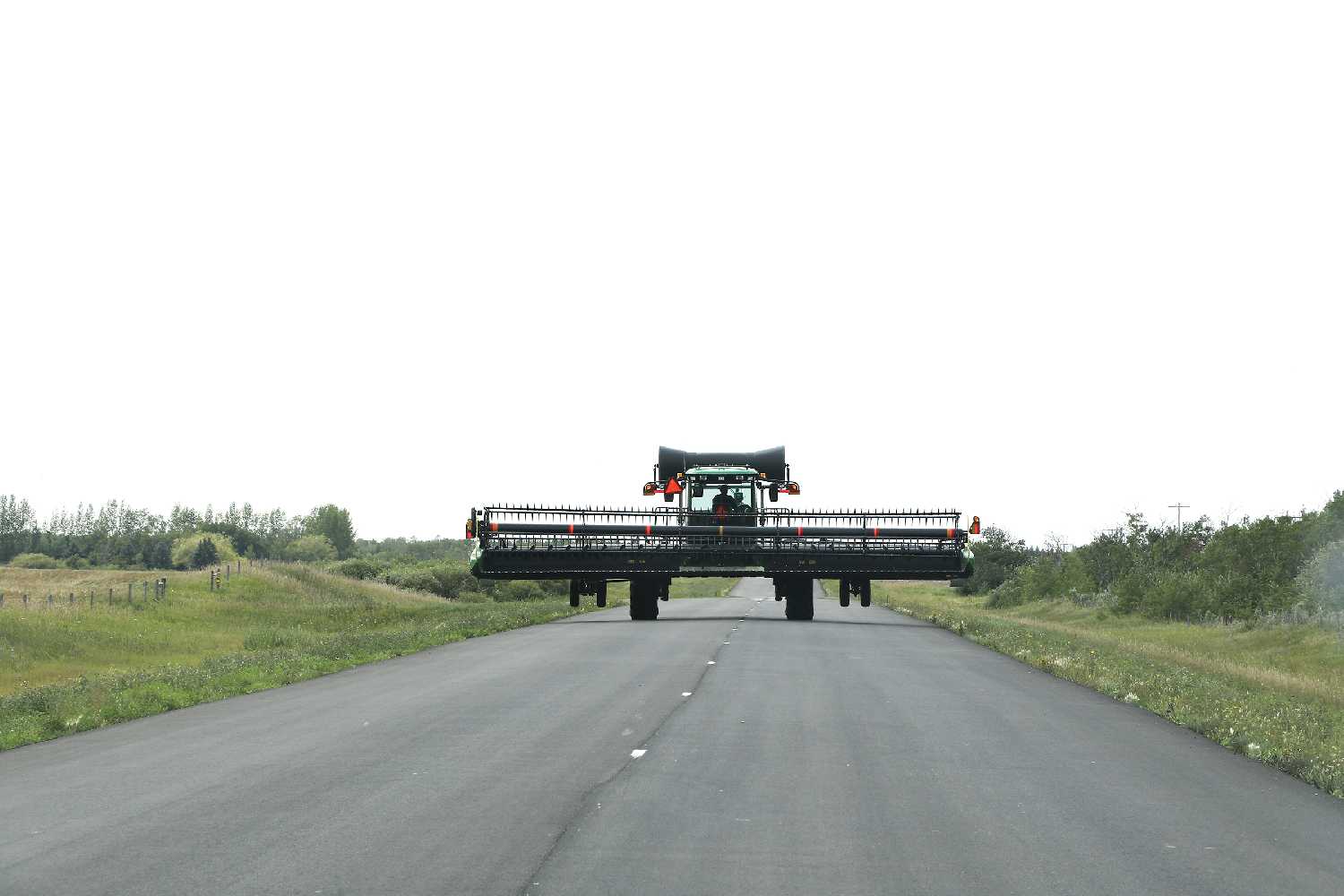Harvest 2021: Low yields but good quality; Rain causes delays
August 30, 2021, 2:20 pm
Kara Kinna


Hot, bone dry weather through the summer, followed by heavy rains right at harvest time—it wasn’t a great combination for farmers this year who were seeing lower yields as they started to harvest before it was halted by unwanted wet weather in Southeast Saskatchewan and Southwest Manitoba over the last few weeks.
But the story isn’t all bad. Much of the wheat coming in is graded at number one or number two. Commodity prices are high. And the rain was needed to replenish moisture on the land and give some relief to cattle producers.
Andy Klippenstein is the general manager of the Parrish and Heimbecker terminal at Hargrave, Manitoba. He says wheat is averaging at 40 bushels and acres this year, as compared to 70 to 80 bushels in previous years, and there are fears that the yield on the canola crops will be down too.
“They’re not into the canola yet. Everybody is kind of gritting their teeth with canola. A lot of people think it might go 20 where other years they were closer to 50. So canola really got beat up by the heat and lack of moisture. It needs water just to fill those pods,” he says.
“And then other crops, barley, oats, they were all half or a little bit less. The hay farmer, they are all saying it’s half a crop out there.
“Quality has been good. Now the rain is going to have an impact on wheat quality a little bit, but what we see now is fitting into the top two grades, which is what the milling industry requires. There might be a little bit of three red. It depends on how much more rain we get. With the standing wheat—fewer and fewer farmers swath, and when you swath that’s when you have the degradation with sprouting. It doesn’t sprout as readily when it’s standing.
“For the most part over half the wheat has been combined already, so I’m thinking that we’re going to fit most of it into a one or two red and maybe a little bit will drop into a number three, which is still a milling wheat but a lower quality. So the quality is holding.
“The protein of course is through the roof, which is good and bad because other years we have a mix of protein, where there is some low and high protein, and it gives you the ability to blend protein and give farmers the benefit of growing the high protein. This year if it’s all high protein, mills, for their purposes for making flour, they want it as about a 13.5 or 13.6 protein and they won’t pay for a 15 per cent protein. They won’t pay a premium for that. In some cases it’s a detriment because if you’re a baker and you have a recipe and you work with certain ingredients in that recipe, when you all of a sudden take one ingredient that is a lot different, you have to skew your whole process because it impacts your whole process, and protein is a big factor in pan breads and things like that.
“Ideally they would like to have a very consistent vanilla product at 13.5 protein and that way they can stick with the recipe that they’ve got.
“In that respect is a bit of a challenge we have. The protein is ranging from 14.5 right through to 17. And other years we’d see a range of high fourteens but then we’d also see lows of 12.5. So it gives you that ability to bring the 12.5 up to 13.5 and 14.5 down to 13.5 and keep everybody happy.”
Mark McCorriston is a farmer who has land in the Moosomin, Rocanville and Fleming areas. He says the wet weather put his harvest on hold and has downgraded the quality of some of his grain, but he points out it has been helpful for pastures and for replenishing moisture on the land.
“We got started harvest before these rains came a week ago or so,” he says. “We managed to get our barley and our oats and part of our wheat crop off. Now we’re kind of on hold. Our wheat is ready to be harvested in the field but now we just can’t get a big enough window to get finished up the wheat harvest.
“On our farm we left it standing and we straight cut it. We did swath the oats and the barley because it was dry and the long-term forecast looked good, but the wheat we left standing. It’s still standing in the field okay now, the seeds have definitely gotten bleached a lot and it’s for sure a number two quality wheat rather than the number one we were taking off before the rain. It downgraded it. The slide from a one to a two isn’t too bad, but when you go from a two to a three, then it really changes.”
McCorriston says the hot, dry weather earlier in the summer has also meant lower yields for farmers around the area, including himself.
“I would say we’re more at the 66 to 75 per cent range of normal harvest for yield, and it’s pretty apparent,” he says. “I’m usually the guy to run the grain auger and I find myself doing odds and ends projects around the yard between loads where I haven’t had an opportunity to do that in several years. It’s a big change. The yields are definitely down.”
Like Klippenstein, McCorriston says his protein content is high.
“In the past years we’ve been high elevens through to twelve and the odd sample in the thirteens for protein. This year every sample that I’ve run over to the local grain terminal to have checked out, the protein’s always been over 15,” he says. “But on average in drought conditions when your yield is down, then your protein always goes up.”
McCorriston says if the prairies can come through with some dry windy weather, then harvest should be able to resume as normal.
“Two or three days of even average weather with no rain for standing wheat to dry up enough that we can harvest it would be good,” he says. “It can probably happen but the other big concern is getting semis on and off the fields. They’re not really designed for conditions like this and then loading on the road is hard on your neighbors and it’s just a little bit more of a dangerous spot to be. I prefer to not use the loading on the road option unless it’s a last resort.
“I’d say if we got five days or four days of average weather with a full day of sun and some wind like this province can definitely provide us with, we would be able to get back and get our wheat finished up.
“On our farm the canola is just not quite ready yet. We’re doing some swathing and we’re doing some desiccating on the canola between the rain days and we’re getting that part of harvest wrapped up so that when it does smarten up we can focus on combining.
“Commodity prices are up so you try to look at the positive, and another positive point is we’re not as desperate as some areas of the province. We do have a crop to harvest. It’s just not what we’ve been used to for the last three or four years. I’m not saying that 2019 wasn’t horribly stressful with the late fall and the snows, but the bushels were there, we just had to work to get them. This year it’s noticeably less yield which is unfortunate, but it definitely could have been worse.”
McCorriston says the wet weather has had little effect on the earlier seeded canola crops, but may have been beneficial to later seeded canola crops.
“Canola’s really up and down and I definiely feel the later canola crops that were seeded in early June are the best because they are still green and producing seeds when we got into this wet period, and now it’s been cooler,” he says. “Earlier canola crops, it was just too late for them. They were already past the stage and had gone into the maturing process, they were already browning up when this rain started. It will help bring the canola in evenly for harvest but for, I would say, 85 to 90 per cent of crops in the area, it was just a little too late for this year.”
Despite the wet weather being an inconvenience at harvest time, McCorriston says he isn’t complaining just yet because it was so dry all summer that there are benefits to this moisture.
“Our pastures at Rocanville and the Moosomin area look like summer time again,” he says. “Our lawn at the farm, it’s a bright, vibrant green and growing again. So there are some blessings. For the livestock it was really, really bad (before with the dry weather) and lots of people were talking about selling parts of their herd. I haven’t heard any rumors like that at the coffee shop since these rains came along. I would say it’s a huge stress relief for the livestock end of it, especially for pastures. Lots of people had poor hay crops, myself included, but now hopefully with these fall rains we can get a little more grazing time on the pastures this fall to help with the lower amount of hay we have for winter feeding.
“As much as the rain was kind of a pain for the grain aspect, right in the middle of harvest, if it’s going to rain off and on for another week I’ll probably just bite my tongue and you won’t hear me complain because it was getting so scarily dry out there. As much as it’s a hindrance, there are so many upsides to this moisture too. And next year for the grain farmers, we’ll have a little bit of potential. These rains, they’ve been excellent at soaking in and not really pooling any water or making the creeks flow. They’ve come just at the right pace so that as they come, the ground is taking it in. There are definitely more bonuses to it than negatives.”



































